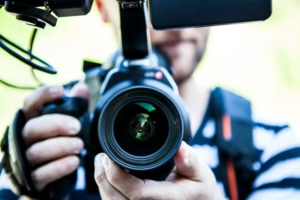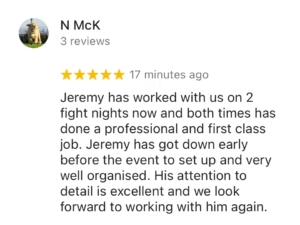Live event videography is the technique and art of capturing critical moments during events as they occur in real time. Live event videography has become increasingly vital in a host of sectors, from corporate events to sports to concerts to weddings to conferences. With audiences seeking more active and engaging content, demand for high-quality video coverage of live events continues to grow.
The worth of live event video is not only in its ability to keep memory but also in the capacity to tell good stories. Corporate events can be enhanced by professional videography so that organisations can project their image authentically, host product launches, or capture key presentations. Such footage can be reused for marketing, training, or stakeholder engagement, greatly expanding the reach and impact of the event.
In sports, live event videography is paramount to delivering maximum viewer experience. With real-time highlighting, frozen scenes, and other camera angles, videographers enhance the way the fans watch the event. It is particularly important in mainstream sports and emerging eSports, where real-time streaming and immediate content form the backbone of engaging a large viewership.
The increased demand for real video content in our modern world cannot be overestimated. With social media and internet streaming sites being video-centric, live event videography is important in making events available to the masses. It’s not so much about shooting; it’s about understanding what the people need, applying the right techniques, and making video connect with the people. Executing this artistry requires skill, foresight, and a complete knowledge of the event, hence making live event videography a compound field to be mentioned.
Types of Live Events that Need Videography
Videography plays a wonderful role in capturing the atmosphere of live events so that experiences can be stored for future enjoyment and reflection. Various types of live events can be enriched by videography, each with their own certain demands and approaches to successful coverage. Familiarity with such delicacies is significant for videographers seeking success in their profession.
Among the most notable forms of live events is conferences. Conferences are filled with keynote speeches, panel sessions, and meeting prospects, all of which contribute to the event’s success. Conference cameramen must be proficient at capturing speakers and audience members as well, often using multiple cameras and intentional angles in order to obtain the atmosphere of the event. High-quality audio is also important, as crisp sound enhances the experience for those who may watch the recordings afterwards.
Weddings are another crucial type of live event where videography is employed to preserve memories. Couples will typically seek out videographers to document their wedding day, from the ceremony to the reception. The dilemma in this case is capturing those spontaneous moments while maintaining respect for the couple’s vision for the wedding movie. It largely requires an unobtrusive working style as well as a sense of understanding of the emotional significance of various moments throughout the day.
Sports activities form another area in which videography is essential. Endless action, celebration, and emotion must be recorded in sports videography. Slow-motion cameras and aerial vehicles are used to ensure any thrilling moment is recorded. Due to the moving nature of sports events, videographers must possess swift reflexes and a thorough understanding of the sporting activity in order to anticipate crucial moments well.
Lastly, concerts provide the opportunity for videographers to utilise their technical skills and creativity. Capturing the energy of live performances often demands creative panning and lighting to be able to bring the atmosphere in a real sense. Not only is the event captured, but this also enhances the experience for audience members who wish to relive the concert later.
Key Equipment for Live Event Videography
Upon beginning a live event videography project, equipment selection is key to obtaining work of professional quality. The first selection of equipment to make is the camera. A low-light-capable high-definition camera, such as a DSLR or mirrorless, will provide the level of clarity and detail in an active setting. Look for versatility, like with interchangeable lenses, which enable videographers to zoom in on pivotal points or capture wide shots, depending on the event’s requirements.
Second, a quality tripod will have stable shots, particularly when using it for extended recordings. A fluid head tripod can offer smooth panning and tilting, allowing the videographer to follow action smoothly without jerky movements. Being equipped with a monopod is also valuable for mobility when it comes to covering large events, making repositioning in an instant without sacrificing stability.
Audio quality is generally just as significant as video quality; therefore, it is important to spend money on good microphones. A shotgun mic is adequate at isolating sound from focused subjects, while lapel (lavaliere) microphones are adequate to capture the voice of speakers clearly in conference settings. For more detailed audio recordings, portable digital recorders can provide better sound quality and more flexibility during post-production.
Lighting should not be overlooked when it comes to event videography. In case the event is taking place indoors or where lighting is poor, outdoor LED lights or softboxes can be employed to illuminate the scene without casting unflattering shadows. Flexible lighting provides ease in adapting to different environments and establishes an appealing ambience in the video.
Lastly, editing software plays an important role in post-production. Programs like Adobe Premiere Pro or Final Cut Pro contain robust video refinement tools, effects addition, and audio mixing capabilities. Employing the proper software, depending on the level of expertise and simplicity of the project ensures a professional-level final output.
Planning and Pre-Production Tips
Successful video capture of live events, conferences, and sports is dependent on careful planning and meticulous pre-production work. The key to successful video recording lies in the level of preparation one does prior to capturing. Coordination with organisers is critical; clear lines of communication ensure coordination with event goals, timing, and specific needs. Understanding the event flow allows one to better predict the pivotal moments that should be captured.
Detailed shot lists are also an important aspect of the planning process. Determining the critical moments and visual storytelling that need to be captured is involved in this process. Critical speeches, audience reaction, and critical sports moments are a case in point. A proper shot list makes it easier during the event, as it keeps the videographers focused and organised. It is preferable to specify not only the type of shots but also the gear to be used for each case to improve the actual process of filming.
Location scouting site visits play an important role in pre-production. Familiarisation with the location helps videographers to have the best ideas on where to set up cameras, lighting conditions, and potential issues. It also allows one to decide on acoustics, natural light conditions, and background that could affect the quality of shots. Scouting also assists in identifying where the best shot locations for dramatic action or speeches are, further enhancing video quality.
Finally, contingency planning is an essential aspect of planning. Live events are never certain, and thus it is prudent to have standby equipment and a flexible shooting plan. By providing solutions to counteract potential technical breakdowns or last-minute scheduling changes, videographers can be confident of seamless capturing of scenes. It not only wards off accidents but also facilitates delivering a polished end product that captivates audiences.
Techniques of Capturing Engaging Footage
In order to create compelling videos while reporting live from events, conferences, and sports, the videographers must employ many techniques which contribute to the viewer’s overall experience. Perhaps the most critical of these is the use of angles. Angles have the power to affect the manner in which the scene is felt, with context-giving wider shots and emotion-focusing close-ups. The presenter’s expressions while presenting at a conference being filmed, for instance, can demonstrate enthusiasm and interest, which have the power to resonate with the viewers.
Motion is also a key factor in attaining interesting footage. The methods of panning and tracking engage the viewer. For example, tracking a speaker who is walking on stage can engage the viewer and make them more interested in what’s going on. Similarly, utilising a slider or gimbal can provide silky-smooth movement and ensure stability, attaining high-quality footage that makes one continue watching.
Framing styles also apply in videography. Using the rule of thirds when framing shots can lead to more aesthetically pleasing videos. Positioning people at intersections of grid lines allows for well-balanced and compelling visuals. Framing people in their environment can also add significance, allowing the viewer to see the significance of the event.
Also, using creative storytelling techniques can amplify the influence of the content significantly. Establishing a narrative structure—starting with an introduction, followed by main events, and culminating in a compelling conclusion—allows viewers to engage with the content on a deeper level. Using voiceovers and interviews, for instance, adds depth to the story by adding layers of perception and understanding.
Weaving these methods carefully will not only make the video more quality-oriented but also engage audiences throughout the journey. With careful attention to angles, motion, composition, and narrative, videographers can create a lasting impact at live events, seminars, and sporting events.
Live Event Videography Challenges and How They Can Be Solved
Live event videography is surrounded by a large number of challenges that are likely to affect the quality of the recorded footage. Arguably, the largest issue is inconsistent lighting. Events tend to take place in various environments, from the lit setting of a conference room to the setting of a concert hall with dark environments. Those variations can lead to dark video or harsh shadows that decrease the overall image quality. To counter this issue, videographers can shell out for good-quality cameras that work well under low light conditions and carry portable light gear to supplement as needed. Pre-event checks also help in analysing lighting conditions and planning for required adjustments.
Quality sound is another common issue. Live events typically generate much ambient noise that can compromise audio recording. This is particularly frustrating in high-activity environments such as sporting events or hectic meetings, where multiple speakers are competing for audience attention. To combat this, the deployment of directional microphones pointed at the target sound source can be helpful. Moreover, the deployment of sound mixing devices enables audio balance and audio clarity streaming so that critical moments are well-recorded without too much distraction.
Crowd interference is also an issue when doing videography of live events. Guests can unknowingly block cameras or generate noise that creates interference in shooting. To counter this, planning is required for camera positioning. Videographers have to advance scout the location to choose optimal locations that give clean lines of sight to the event with minimal interruption to the crowds. Furthermore, great communication with event coordinators can help to reserve the allocated shooting area for video shooters to work efficiently without destroying the crowd experience.
With proper preparation and implementation of these best practices, videographers will find it easier to work through the technicalities of live event coverage and produce quality output that captures the essence of the moment.
Post-Production: Editing and Improving Video Content
Post-production is also an essential aspect of videography as it plays a crucial role in turning raw footage into polished, interesting content. By editing, one has to select and arrange the best clips to produce a compelling story that effectively conveys the live event, conference, or sports action’s message. Editing allows for the elimination of the unwanted parts, thereby focusing the audience’s attention on the most significant moments.
Graphics are also an important aspect of post-production. Titles, logos, and lower thirds are some of the graphics used. They can contribute meaningfully to the viewer’s experience. The graphics must complement the theme of the event and be consistent with the brand. Visual elements properly used make the video experience better, but most importantly, provide valuable information in helping to set the context for the viewer.
Audio enhancement is similarly crucial in the post-production process. Quality audio plays an immense role in the overall viewing experience of a video. Well-synchronised sound, eliminating background noise, and audio levelling are essential. In addition, adding background music or sound effects can increase the emotional involvement of the viewers to the content. The choice of music also has to be the same style as the video; i.e., quick-tempo music would suit the sports highlight reel, and lighter themes would suit a corporate convention better.
Consistency of style across all the edited videos is also vital as it helps to build a recognisable brand image. These are decisions of colour grading, transition, font styles, and pacing. Ultimately, optimisation of videos for multiple platforms—be it social media, websites, or online marketing—delivers maximum reach and engagement. Each platform may have specific requirements in terms of duration, resolution, and format, and therefor,e the final output must be tailored accordingly.
The Application of Live Streaming in Videography
Live streaming revolutionised the way events, conferences, and sports are recorded and shared with viewers. This new trend offers an opportunity for videographers to step out of geographical limitations so that they can reach a wider crowd. With live streaming as part of their collection, videographers can engage more viewers and deliver a better experience to those who cannot be present. The importance of presenting content in real time cannot be overstated since it ignites a live interaction with the audience and drives real-time engagement.
For one to use live streaming effectively, videographers must become familiar with various instruments and platforms suitable for broadcasting. The most popular platforms include YouTube Live, Facebook Live, and Twitch, each with different features and functionality. Choosing the best platform is a function of the target audience and the demands of the event being streamed. Videographers must also spend money on quality equipment, including HD cameras, good-quality audio equipment, and stable broadband connections in order to make the live stream professional-level quality. This investment makes a huge difference in the level of quality that a live stream can achieve, something that resonates with the videographer’s pride in showing top-notch content.
Secondly, the incorporation of the right strategies in live streaming can enhance audience participation. The inclusion of live chat, polls, and viewer Q&A sessions opens a two-way communication portal between the audience and speakers. Not only does this keep viewers active, but it also encourages them to stay actively involved, enhancing the overall experience. Pre-event promotion, such as teaser videos and countdowns, can further generate buzz and anticipation among potential viewers.
Finally, live streaming is a fundamental part of contemporary videography, offering new ways to reach and interact with audiences in the digital era. Through learning to use the appropriate tools and techniques, videographers can take their work to a higher level and help to preserve the spirit of the event as it appears before a worldwide audience, making every broadcast an unforgettable event.
Conclusion: The Future of Live Event Videography
The value of videography in documenting live events, be they conferences, sports, or other functions, remains just as true. Being able to document these experiences not only allows for reliving pleasant memories but also offers the option of increased audience participation, enabling those who cannot attend personally to feel as though they are witnessing the event in video. With live events growing in size and scale, the role of videographers will become ever more important in telling engaging stories that connect with the viewers.
Technological advancement in the coming times will revolutionise the landscape of live event videography. Technologies such as augmented reality (AR) and virtual reality (VR) will change the experience of watching these events for audiences, providing interactive experiences beyond viewing norm. Additionally, high-definition video, drones, and 360-degree cameras will allow videographers to capture action from various angles and facets, contributing to further quality in the production. This will also mean that filmmakers not only need to familiarise themselves with new equipment but also adopt new narrative techniques that make use of these equipments.
Still, the transition to digital platforms means audience perceptions are continually evolving. Videographers will have to remain attuned to the preferences and habits of their viewers, ensuring that their productions are not just visually appealing but also appealing and effective. Communication with individuals through social media and interactive content will also enhance the experience, developing a two-way connection between the producers and viewers. As the industry evolves, it is imperative that videographers make a point of ongoing learning and development, readying themselves for impending challenges and opportunities in the ever-changing field.





